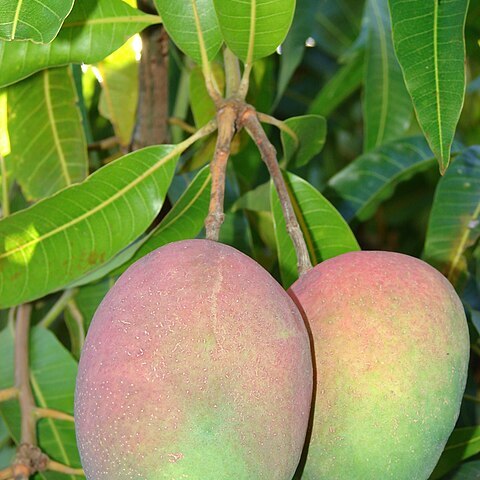Erect, branched evergreen trees. Leaves alternate, petiolate, simple, entire, with the lateral nerves arched and anastomosing near the margin. Flowers polygamous with male and hermaphrodite flowers in the same terminal or subterminal panicles. Sepals usually 5 (rarely 4–7), free, imbricate. Petals usually 5 (rarely 4–7), imbricate, inserted between the disk-lobes, with 3–5 darker yellow nerves on the inner surface with the median one prolonged like a crest at the base. Stamens 5–10, 1 (–2–5) fertile, the others sterile; filaments filiform; anthers ovoid. Disk 4–5-lobulate or vestigial. Ovary subglobose, 1-locular, 1-ovulate; style subterminal or lateral, incurved, with a single stigma. Fruit a fleshy drupe, subreniform or ovoid with a fleshy mesocarp and a fibrous woody endocarp. Seed oblong-ovoid, compressed, with a chartaceous testa; embryo with cotyledons plano-convex, sometimes lobed, and the radicle ascendent.
Trees, often attaining great size. Leaves petiolate, the blades simple and en-tire. Panicles terminal, large, the bracts deciduous. Flowers X, the pedicels artic-ulated; calyx-lobes 4-5, imbricate, deciduous; petals 4-5, free or adnate to the disc, imbricate, the nerves often ridged ventrally; stamens usually 5 (rarely 10-12), with 1 fertile and much larger than the rest (rarely with 2, 3 or all 5 fertile); disc extrastaminal, 4-5-lobed, tumid or less frequently much reduced; ovary 1-car-pellate, 1-locular, the solitary ovule affixed just above the base of the locule, the style excentric. Fruit a fleshy drupe with a large, compressed seed. A genus of about 53 species indigenous to tropical and subtropical Asia; one species is cultivated throughout the tropics of the Old and New World (including Panama) for its edible fruit.
Evergreen trees, andro-monoecious with functionally staminate and bisexual flowers in same inflorescence. Leaves petiolate, simple; leaf blade margin entire. Inflorescence a terminal pleiothyrsoid. Flowers small, 4-or 5-merous, with imbricate aestivation. Sepals sometimes united at base. Petals with 1-5 prominent veins adaxially. Stamens 5, free or united with disk basally, usually 1(or 2) noticeably larger. Disk of 5 separate extrastaminal glands. Ovary glabrous, 1-locular, 1-ovulate; style 1, terminal. Fruit drupaceous; mesocarp fleshy or fibrous; endocarp thick and bony, compressed. Embryo 1 to several by polyembryony.
Andromonoecious trees. Leaves simple, alternate, entire. Inflorescence terminal and/or axillary. Pedicels articulate. Sepals 4 or 5. Petals 4 or 5, imbricate, sometimes bearing glandular ridges on inner surface. Disc mostly extrastaminal. Fertile stamens 1 or 2, rarely (not in Australia) 5–12, with or without staminodes. Anthers dorsifixed. Ovary 1-locular, abortive in male flowers. Style eccentric or lateral; stigma simple. Fruit a drupe; exocarp coriaceous; mesocarp fleshy; endocarp woody and fibrous. Seed with testa free from endocarp, sometimes polyembryonic. Embryo straight; cotyledons plano-convex.
Petals 4–5, imbricate, inserted between the disk-lobes, with 1–5 somewhat prominent nerves, the median one prolonged like a crest at the base of the internal face.
Leaves alternate, petiolate, entire, with the lateral nerves arched and anastomosing near the margin; petiole hemicylindric, thickened at the base.
Seed oblong-ovoid, compressed, with a chartaceous testa; embryo with cotyledons plano-convex, sometimes lobed and the radicle ascendent.
Ovary subglobose, 1-locular, 1-ovulate; style subterminal or lateral, incurved, with a single stigma.
Stamens 5–10, 1 (2–5) fertile, the others sterile; filaments filiform; anthers ovoid.
Drupe subreniform or ovoid with a fleshy mesocarp and a fibrous-woody endocarp.
Flowers polygamous, in terminal or subterminal panicles.
Sepals 5 (rarely 4), free or nearly so, imbricate.
Disk 4–5-lobulate or vestigial.
Trees.

